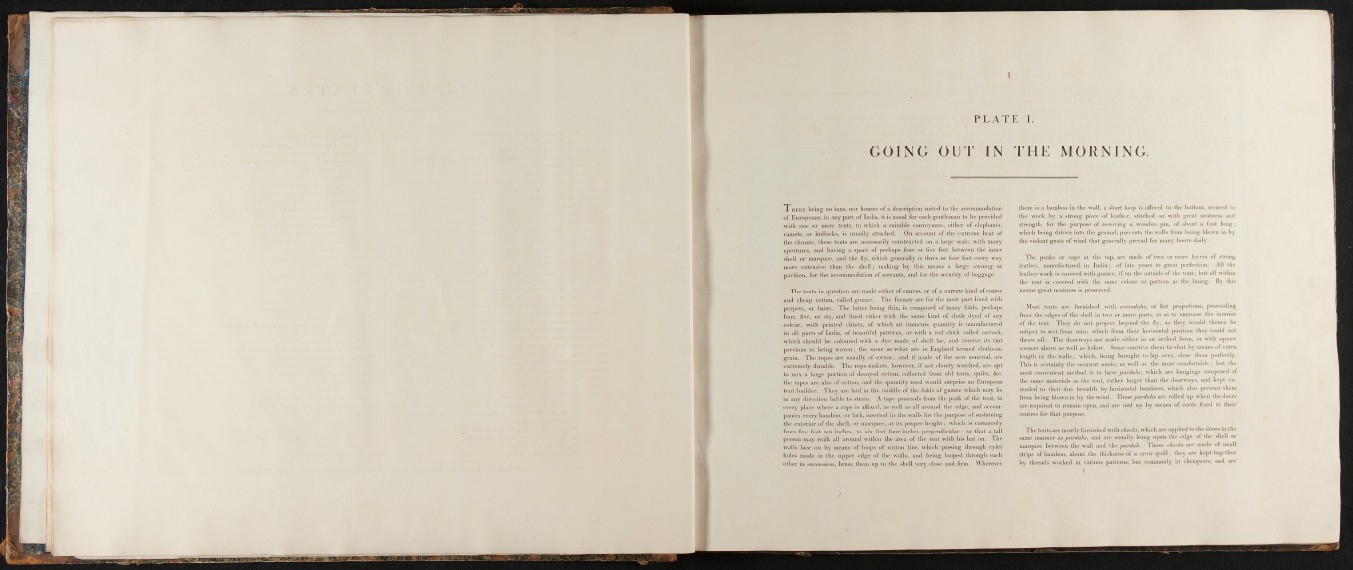
P L A T E I.
GOING OUT IN THE MORNING.
THERE being no inns, nor houses of a description suited to the accommodation
of Europeans, in any part of India, it is usual for each gentleman to be provided
with one or more tents, to which a suitable conveyance, either of (elephants,
camels, or bullocks, is usually attached. On account of the extreme heat of
the climate, these teats are necessarily constructed on a large scale, with many
apertures, and having a space of perhaps four or five feet between the inner
shell or marquee, and tlie ilj', which generally is three or four feet eveiy way
more extensive than the shell; making by this means a large awning or
pavilion, for the accommodation of servants, and for the security of baggage.
The tenls in question are made either of canvas, or of a narrow kind of coarse
and cheap cotton, called gnzzce. The former are for the most part lined with
perpets, or baize. The latter being thin, is composed of many folds, perhaps
four, five, or six, and lined eitlier with the same kind of cloth dyed of any
colour, with printed chintz, of which an immense quantity is manufactured
in all parts of India, of beautiful patterns, or with a red cloth called curroch,
which should be coloured with a dye made of shell lac, and receive its lint
previous to being woven; the same as what arc in England termed cloths-ingrain.
The ropes are »isually of cotton ; and if made of the new material, are
extremely durable. Tho rope-makei's, however, if not closely watched, are apt
to mix a large portion of decayed cotton, collected from old tents, ([uilts, &c.
the tapes are also of cotton, and the quantity used would surprise an European
tent builder. They are laid iu the middle of the folds of guzzce whicii may be
in any direction liable to strain. A tapo proceeds iVoni ihe peak of the tent, to
every i)lace where a rope is ailixcd, as well as all around the edge, and accomjiauies
every baml)oo, or lath, inserted in the walls for the ])urpose of sustaining
Uie exterior of the shell, or mar([uce, at its proper height ; wliich is commonly
from live feet len inches, to six feet four inches perpendicular : so that a tall
person may walk all around within tlie area of the tent with his hat on. The
\valls lace on by means of loo[)s of cotton line, which passing through eyiet
holes uuide in the upper edge of the walls, and being looped ihrougli each
other in succession, brace them up to the shell very close and firm. Wherever
there is a bamboo in the wall, a short loop is ailixed to the bottom, secured to
the work by a strong piece of leather, stitched on with great neatness and
strength, for the purpose of receiving a woodeu pin, of about a foot long;
which being driven into the ground, prevents the walls from being blown in by
the violent gusts of wind that generally prevail for many hours daily.
The peaks or caps at the top, are made of two or more layers of strong
leather, manufactured in India; of late years to great perfection. All the
leather work is covered with guzzce, if on the outside of the tent; but all within
the tent is covered with the same colour or pattern as the lining. By this
means great neatness is preserved.
Most tents are furnished with verandahs, or flat projections, proceeding
from tlie edges of the shell in two or more parts, so as to encrease the interior
of the tent. They do not project beyond the; ily, as they would thence be
subject to wet from rain; which from their horizontal position they could not
throw oil. The doorways are made either in an arched form, or with square
corners above as well as below. Some contrive them to shut by means of extra
length in the -walls; wliich, being brought to la|) over, close them perfectly.
This is certainly the securest mode, as well as tlie most comfortable; but the
most convenient method is to have purdahs, which are hangings composed of
the same materials as the tent, rather larger than the doorways, and kept extended
to their due breadth by horizontal bamboos, which also prevent tliem
from being blowuin by the wind. These/»¿írc/ü/is are rolled up when the doors
are required to remain open, and are lied up by means of cords lixeil to their
centres for that purpose.
The tents arc mostly furnished with cheeks, which are applied to the doors in the
same manner as purdahs, and are usually hung upon the edge of the shell or
marquee between the \vall and the purdah. These chceh are made of small
strips of bamboo, about the thickness of a crow (piill; they are kept together
by threads worked in various patterns, but commonly in checquers, and are